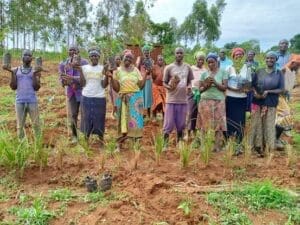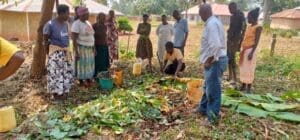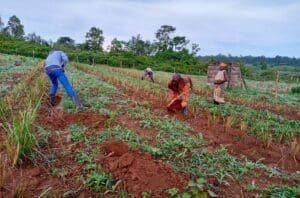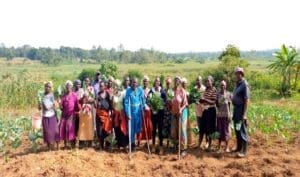
RAPPORTEUR –Notes taken by Pauline Saris, program coordinator
ACTIVITY OVERVIEW
Sustainable Village Resources (SVR) is a registered CBO in Kenya. We work with marginalized stay at home communities whose main livelihood depends on the small pieces of land they own. Some do handicraft while others venture into small scale poultry. Bottom line is their main source of income is the small pieces of land. We sought to get them from living on hand to mouth and get them to a sustainable living where they can get nutritious food and get economically empowered while ensuring food security from their land.
1. INTRODUCTION TO VETIVER GRASS REGENERATIVE FARMING.
-
- Training started with Caleb Omolo taking the Lela Modern Farmers through Vetiver grass regenerative farming. The content to be

Documenting Vetiver Regenerative Agriculture with local news reporter. adopted here was changing from monoculture to polyculture system of farming. The farmers were asked to identify some of the challenges they face while they practice farming. Among those listed are, low yield, high cost of industrial fertilizer, invasion of the striger weed, losing topsoil through wind and rainfall runoff, soil hard pans, unpredictable rain patterns due to climate change. All of the farmers attributed the spike in industrial fertilizer to the Russia-Ukraine war.
- Caleb then proposed an alternative system called Vetiver Grass Regenerative farming which does not need industrial fertilizer. It relies on locally indigenous seeds, stops the runoff caused by soil and wind erosion, cures the striger weed invasion, and rebuilds the soil using biological means instead of industrial fertilizer. This method, as Caleb explained uses polyculture which has seven layers: Tubers, Cover crops, Understory, Climbers, Overstory, Canopy and the Climax all maturing at different times. The farmer will be able to have income on rotation throughout the year.
- Christian Makokha, The co-trainer took the participants through Vetiver Hedgerow and on-farm contour mapping using vetiver grass and vetiver nursery establishment. The essence was to stop the run off using the vetiver hedgerows.
- Training started with Caleb Omolo taking the Lela Modern Farmers through Vetiver grass regenerative farming. The content to be
2.TERMS OF ENGAGEMENT
The ground rules that were agreed on by participants to abide by during the 6 months training are:
- In the first week theory training starts at 7am, tea break at 10:30 am, lunch break at 1pm, meeting ends at 4pm negotiable up to 5pm
- Afterwards, for six months, reporting on demo farm is at 7:00 am to 10:30 am every Friday
- Respect each other’s opinions
- Give each other opportunity to learn and unlearn
- Make the place a safe space
- Minimize use of phones
- Keep time
3. PARTICIPANTS’ EXPECTATIONS
The following were the expectations that participants wrote down before the training begun:
- To gain more skills on vetiver grass regenerative farming
- To learn more about Vetiver Grass
- To learn about poly culture
- To learn more on improving land use and utilization
- To learn how to manage small pieces of land
- To learn about financial management
4. OBJECTIVES OF THE TRAINING
- To introduce vetiver grass regenerative farming as an alternative to monoculture industrial farming.
- To enhance participants’ skills/knowledge on vetiver grass regenerative farming.
- To practically help participants understand how to grow nutritious food and income generating activities from small farms
- To help participants understand the concepts of poly culture system of farming.
- To help participants understand different on farm applications of vetiver grass.
Bio complete compost manure .

A team of 35 members enrolled from the community were taken through theoretical and practical part of making the bio-complete compost manure. The sessions entailed collecting locally available biodegradable material to complete this process. Here, two leads were identified from the community. They will be responsible for ensuring the bio complete is turned and ready by the time for planting.
Vetiver regenerative farm design.
Caleb walked the group through the process of designing vetiver regenerative food forest using succession where annual and cover crops are used extensively to shade young tree seedlings from wind and sun exposure. He also explained how the three sisters system of farming works: Maize, Pumkins and beans.

Farm Layout.
Caleb took the group through the process of laying trenches in the farm and outlining placement of tree, vetiver grass and crop lines. The trenches and logs layout are meant to absorb water, and attract beneficial fungus and bacteria.
Caleb explained the importance of the logs and vetiver grass in relation to crop yields and production. He also explained the difference between biological soil full of bacteria and fungi and dead soil.
Seven layer methods, the participants then set up the food forest in between vetiver rows: Tree line — Vetiver grass line — Crop line repetitively.

CHALLENGES & LEARNING
- Vetiver regenerative agriculture is a fairly new concept in Kenya and therefore very few people can train; the consultant takes 2 days on the road to train for a day (a few hours)
- We realized that the content was wide and heavy, and the time provided for training was shorter.
- The adaptation rate was a bit slow in the beginning
- Budget constraints, it is very expensive to accommodate the trainers every week
OBSERVATIONS.
- Due to no weeding required, the farmers have a lot of free time
- The farmers are still very skeptical even though there is a chance to get multiple income. This is attributed to their disappointment in farming in previous years.
RECOMMENDATIONS
- The community to produce Trainers of Trainers (ToTs) from the lot that participated so that knowledge and skill acquired is shared effectively.
- The farmers can be taken through value addition training to enable them learn weaving using vetiver grass and basket making to help manage their free time.
ACTIVITY OUTCOMES
- Participants used the skills they acquired to set up their kitchen gardens.
- The participants are becoming financially independent by selling produce from their kitchen garden
- The participants are scaling the project to the second phase- planting bi-annuals.
- The farmers have adopted the seven layer design that cushions them against any unforeseen disasters e.g flooding, drought, locust infestation e.t.c
- Great scaling opportunities. A replica of the same project is being implemented in Busia county.